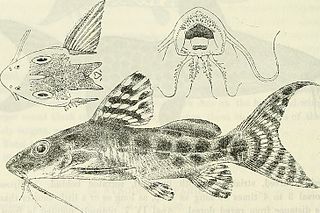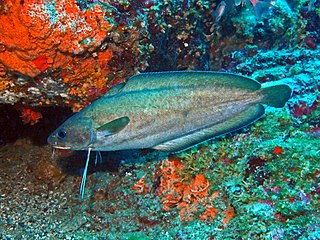
The smoothback angelshark is an angelshark of the family Squatinidae found in the eastern Atlantic and Mediterranean.

Synodontis membranaceus, known as the moustache catfish, is a species of upside-down catfish that is native to northern Africa. It was first described by French naturalist Geoffroy Saint-Hilaire in 1809 as Pimelodus membranaceus, from specimens obtained in the Nile River. The species name membranaceus refers to membranes present on the barbels of the fish.

Synodontis nigrita, known as the false upside down catfish, is a species of upside-down catfish that occurs widely in northern Africa. It was first described by French zoologist Achille Valenciennes in 1840. The type specimen is in the Muséum National d' Histoire Naturelle de Paris.

Epalzeorhynchos is a small ray-finned fish genus of the family Cyprinidae. Its members are – like some other cyprinids – known as "freshwater sharks" or simply "sharks". They are, however, freshwater members of the Osteichthyes lineage which is distinct from the Chondrichthyes lineage of sharks. The description of these animals as "shark" is most likely a reference to the shark-like shape of these popular cyprinids.

Synodontis caudovittatus, known as the white-finned synodontis, is a species of upside-down catfish that is native to the Nile basin of Ethiopia, South Sudan, and Sudan. It was first described by British-Belgian zoologist George Albert Boulenger in 1901, from specimens collected in the White Nile, at the mouth of Lake No in South Sudan. The species name caudovittatus comes from the Latin word cauda, meaning "tail", and the Latin word vitta, meaning "stripe" and refers to the coloration of the tailfin.

Synodontis clarias, known as the red tailed synodontis, or the mandi, is a species of upside-down catfish that occurs widely in the waters of northern Africa. It was first described by Swedish zoologist Carl Linnaeus in 1758 as Silurus clarias. The original specimens were obtained in Egypt, near Cairo. The meaning of the species name clarias is not certain, but may possibly have been used to mean "bright" or "clear".

Synodontis filamentosus, known as the longfin synodontis, is a species of upside-down catfish that is native to the basins of the Nile, Volta and Niger Rivers as well as the Chad Basin. It was first described by British-Belgian zoologist George Albert Boulenger in 1901, from specimens obtained near the mouth of Lake No, on the White Nile in Sudan. The species name filamentosus comes from the elongated rays of the dorsal and caudal fins.

Synodontis frontosus, known as the Sudan squeaker, is a species of upside-down catfish that is widely distributed throughout northern and central Africa. It has been reported in Chad, Democratic Republic of the Congo, Ethiopia, Kenya, Somalia, Sudan, and Uganda. It was first described by French zoologist Léon Vaillant in 1895, from specimens collected in the White Nile in Sudan. The species name frontosus is Latin, and means "broad head".

Synodontis geledensis, known as the Geledi squeaker, is a species of upside-down catfish that is native to Ethiopia, Kenya and Somalia where it can be found in the Lorian Swamp, the Shebelle and Ewaso Ng'iro rivers. It was first described by German zoologist Albert Günther in 1896, from specimens obtained near Geledi, on the Shebeli River in east Africa. The species name geledensis comes from Geledi, Somalia, the location where the first specimens were first found.

Synodontis ornatipinnis, known as the barfin synodontis, is a species of upside-down catfish that is native to the Congo Basin of the Democratic Republic of the Congo and Zambia. It was first described by British-Belgian zoologist George Albert Boulenger in 1899, from specimens collected in Mbandaka, on the Congo River in what is now the Democratic Republic of the Congo. The species name ornatipinnis means "ornate fins".

Synodontis pardalis is a species of upside-down catfish that is endemic to Cameroon where it occurs in the Dja River drainage. It was first described by British-Belgian zoologist George Albert Boulenger in 1908, from specimens collected in the Dja River in southern Cameroon. The species name pardalis is derived from the Greek word pardalis, which means "leopard", which refers to the spotted pattern on the fish.

Synodontis resupinatus is a species of upside-down catfish that is native to the Niger basin and the Bénoué River of Cameroon, Mali, and Nigeria. It was first described by British-Belgian zoologist George Albert Boulenger in 1904, from specimens obtained near Lokoja, Nigeria.

Synodontis robbianus, known as the russet synodontis, is a species of upside-down catfish that is native to Nigeria where it is found in the Cross and lower Niger Rivers. It was first described by John Alexander Smith in 1875, from specimens collected in the Calabar River, Nigeria. The species name robbianus is named after Rev. Alexander Robb, a Scottish missionary, who collected the original species samples.

Synodontis serratus, known as the shield-head squeaker, is a species of upside-down catfish that is native to the Nile basin of the Democratic Republic of the Congo, Egypt, Ethiopia and Sudan. It was first described by German naturalist and explorer Eduard Rüppell in 1829, from specimens obtained near Cairo, Egypt. The species name serratus comes from the Latin word serra, meaning "saw", which refers to the serrated pectoral spines of the species.

Synodontis sorex is a species of upside-down catfish that is widely distributed in the rivers of northern Africa. It was first described by German zoologist Albert Günther in 1864, from specimens obtained in the upper Nile River, near Khartoum, Sudan. The species name sorex comes from the Latin word for shrew or shrew-mouse, the allusion was not explained. It possibly describes the pointed snout or the long, slender teeth.

Heterobranchus bidorsalis, the African catfish or eel-like fattyfin catfish, is an airbreathing catfish found in Africa. It is closely related to the vundu catfish, which is well-known among fishermen.

Cirrhibarbis capensis, the barbelled klipfish, is a species of clinid found in subtropical waters of the Atlantic Ocean around South Africa. This species can reach a maximum length of 36 centimetres (14 in) TL. This species preys primarily on benthic crustaceans, mostly amphipods and isopods. It is currently the only known member of its genus.
Clinus brevicristatus, the Cape klipfish, is a species of clinid that occurs in subtropical waters of the Atlantic Ocean around South Africa where it prefers habitats with plentiful growth of seaweed. This species can reach a maximum length of 12 centimetres (4.7 in) TL.

Chaetodon hoefleri, the four-banded butterflyfish, is a species of marine ray-finned fish, a butterflyfish from the family Chaetodontidae. It is native to the tropical eastern Atlantic and has been recorded in the Mediterranean.

Phycis phycis, the forkbeard, is a species of phycid hakes in the family Phycidae.



















